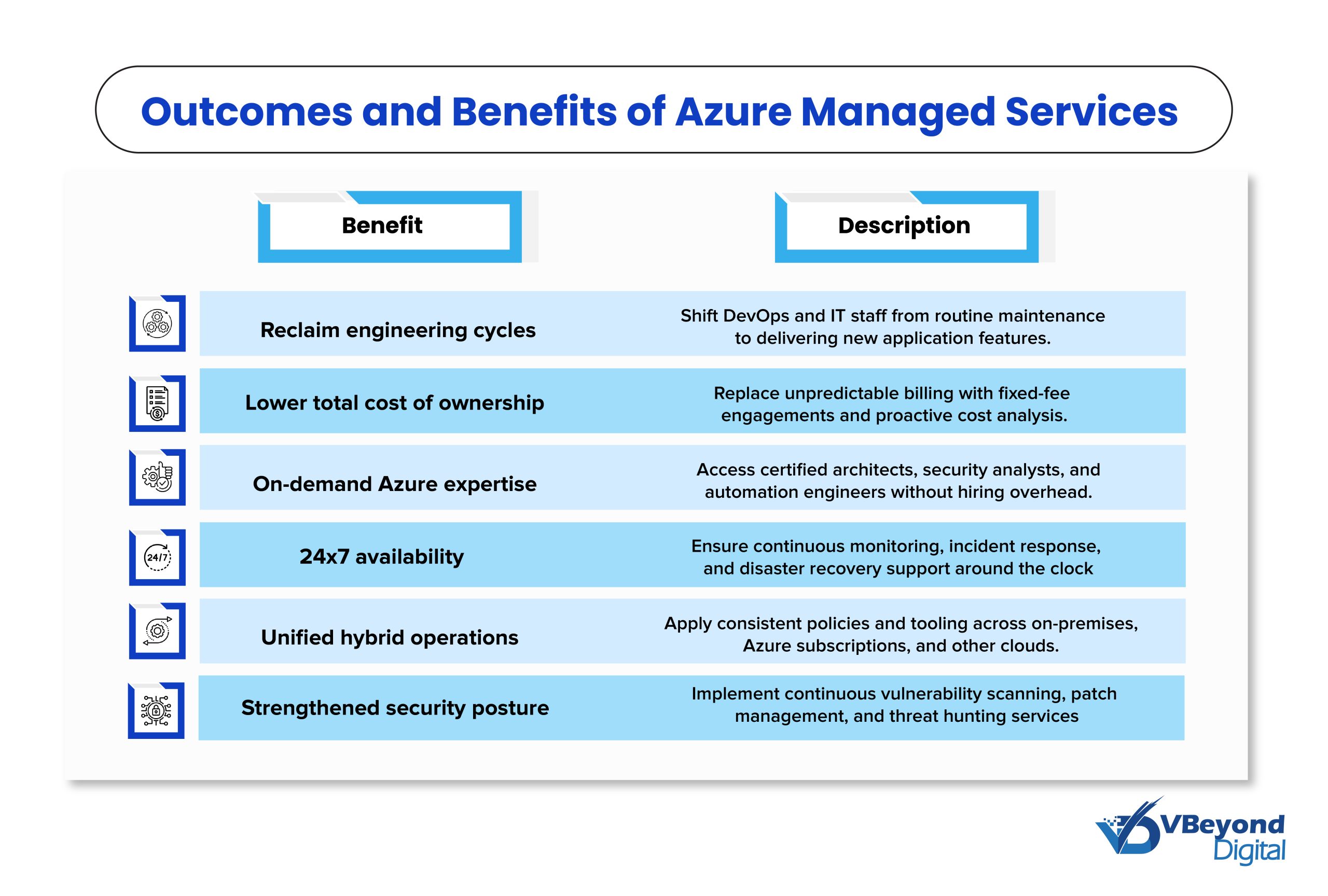When & Why to Outsource Azure Managed Services: A Business-Driven Perspective
Section
Table of Contents
- Decision Triggers: Recognizing When to Outsource Azure Management
- Outcome‑Led Benefits: What Outsourcing Enables Your Business to Do
- Choosing the Right Azure MSP: Key Selection Criteria
- Roadmap to Engagement: From Pilot to Production
- Measuring Success: Metrics and KPIs
- Conclusion
- FAQs ( Frequently Asked Questions)
This blog explains when to outsource Azure managed services and why CIOs should consider an Azure managed service provider. It outlines decision triggers such as rapid scale-up, compliance demands, cost unpredictability, and 24×7 monitoring needs. It presents outcome-led benefits including reclaimed engineering cycles, cost stability, on-demand expertise, and enhanced security.
- Key Decision Triggers for Azure Managed Services – Organizations facing rapid scale-up requirements, stringent compliance demands, unpredictable cloud costs, and the need for twenty-four-seven monitoring often choose to outsource Azure managed services. This approach frees internal teams from routine tasks and addresses gaps in governance frameworks and disaster recovery planning.
- Outcome-Led Benefits of Outsourcing – Engaging an Azure managed service provider delivers expert support that reduces the burden on in-house staff, enforces disciplined Azure cost optimization, and guarantees proactive twenty-four-seven incident response. Companies gain real-time monitoring dashboards, performance tuning, and in-depth reporting capabilities without the overhead of recruiting specialized talent.
- Consultative Engagement Model – A proven MSP engagement typically begins with a discovery and assessment phase that audits workloads, maps business outcomes, and establishes ROI. Strategic planning workshops align cloud operations with product roadmaps. Architecture and design sessions define target state frameworks. Migration and onboarding use staged testing and runbooks. Ongoing operations include automated monitoring, incident management, and quarterly innovation reviews.
- Roadmap and Success Metrics – A phased rollout starts with a ninety-day pilot to validate monitoring, incident response, and cost-control mechanisms. The three-to-six-month scale-up phase extends coverage, refines automation, and integrates ITSM and SIEM toolchains. Production support delivers full service-level agreement compliance. Continuous optimization focuses on performance metrics, cost variance under five percent, mean time to resolution reductions, and one-hundred-percent compliance audit pass rates.
Cloud-driven growth demands more than just rapid deployments. In fact, it requires the ability to innovate quickly while maintaining operational stability at scale. For enterprises running global workloads, downtime can erode customer trust and directly impact revenue, making resilience just as important as speed.
Yet internal IT teams often face a constant trade-off. On the one hand, they’re expected to launch new features and deliver strategic projects. On the other, they’re tied up managing tickets, patching systems, maintaining infrastructure, and troubleshooting performance issues. This reactive mode consumes valuable engineering cycles, limits strategic focus, and delays innovation.
When operational demands begin to exceed internal bandwidth, whether due to scaling pressures, compliance obligations, or cost unpredictability, outsourcing Azure management becomes a strategic lever. An Azure Managed Service Provider (MSP) can offload routine operations, strengthen governance, and free in-house teams to focus on the architecture, performance, and automation initiatives that drive competitive advantage.
These inflection points aren’t the same for every organization, but there are common patterns. The following decision triggers can help you determine when it’s time to bring in an Azure MSP.
Deploy Azure Managed Applications today.
Decision Triggers: Recognizing When to Outsource Azure Management
Businesses often engage an Azure Managed Service Provider when internal teams hit capacity limits or face complex compliance requirements that divert focus from innovation and product delivery.
Some of the common triggers for this include:
- Rapid scaling up requirements that demand continuous provisioning, configuration tuning, and autoscaling beyond in-house bandwidth.
- Heightened compliance and security needs in regulated industries requiring advanced governance, encryption, and audit capabilities.
- Unpredictable cloud costs driven by fluctuating usage, storage, and compute, creating budget overruns without disciplined optimization.
- 24×7 monitoring and disaster recovery needs, where downtime directly impacts revenue and customer experience.
- Hybrid or multi-cloud complexity requiring consistent policy enforcement and tooling across environments.
When these pressures mount, outsourcing to a certified Azure MSP ensures stability, cost control, and the freedom for internal teams to focus on strategic growth initiatives.
Outcome‑Led Benefits: What Outsourcing Enables Your Business to Do
Outsourcing Azure managed services delivers measurable outcomes that directly enable engineering teams to focus on feature development while ensuring infrastructure stability across critical workloads and business workflows.
External managed service providers bring proactive support frameworks and subject matter expertise that reduce operational overhead and align cloud operations with organizational objectives.
- Reclaim engineering cycles by redirecting DevOps and IT resources from routine maintenance activities toward delivering new application features and strategic innovation initiatives that drive business growth.
- Stabilize and lower total cost of ownership through fixed-fee Azure cost optimization engagements that replace unpredictable consumption billing with predictable budget forecasting and disciplined spending controls.
- Access on-demand Azure expertise from certified architects, security analysts, and automation engineers without the overhead of recruiting, training, and retaining specialized in-house staff.
- Guarantee twenty-four-seven availability with proactive monitoring, automated incident resolution, and disaster recovery drills that reduce mean time to recovery to minutes instead of hours.
- Unify hybrid and multi-cloud operations under a single pane of management, applying consistent governance policies, automation toolchains, and compliance reporting across on-premises resources and cloud subscriptions.
- Strengthen security posture with continuous vulnerability scanning, patch management, and threat hunting services that close exposure windows faster than periodic manual processes.
- Scale capacity elastically in response to seasonal peaks or sudden market opportunities, leveraging automated provisioning and deprovisioning to control costs and maintain performance SLAs.
- Gain real-time visibility through customizable dashboards and analytics that surface performance, spend, and risk metrics across all Azure subscriptions for data-driven decision making.
Choosing the Right Azure MSP: Key Selection Criteria
Engaging an Azure managed service provider demands rigorous vetting of core competencies covering partner certification status, proven enterprise references, service breadth in Azure cloud management, and flexibility in engagement models. Critical evaluation of contract terms around response SLAs, cost models, and penalty clauses ensures predictable Azure support services alignment with your governance and risk frameworks. Integration capabilities with existing toolchains such as ServiceNow, Azure DevOps, Splunk, and SIEM platforms enable unified operations and consistent compliance across hybrid and multi-cloud environments.
Finally, assessing global delivery capacity paired with local support presence combined with a structured business review process ensures ongoing enhancement of your Azure migration strategy and operational outcomes.
- Certified Azure Partner status: Select providers holding Azure Expert MSP designation who have met strict performance, skilling, support program, and CSP program requirements validated through independent third-party audits.
- Proven enterprise references: Require at least four verifiable customer case studies demonstrating successful Azure managed services engagements in your industry vertical and similar technology scales to confirm real world capabilities.
- Service coverage: Ensure the provider offers end-to-end Azure cloud management capabilities across all critical operational domains, including monitoring, security, backup, disaster recovery, DevOps, networking, and data services.
- Flexible engagement models: Evaluate options for white labeled, co-managed, and fully managed service approaches that align with your governance requirements, organizational structures, and internal team collaboration preferences.
- Transparent SLAs and cost models: Review sample invoices, service level agreement terms, and penalty clauses to validate commercial alignment, risk sharing, and predictable Azure cost optimization outcomes over the contract duration.
- Toolchain integration: Confirm seamless integration hooks for ServiceNow, Azure DevOps, Splunk, and other existing ITSM, SIEM, and automation platforms to maintain workflow consistency and centralized operational visibility.
- Global delivery and local support: Balance offshore resource efficiency with onsite compliance and language support capabilities across time zones, ensuring both scale and rapid incident response coverage.
- Continuous improvement process: Require quarterly business review sessions tied to defined KPIs, operational dashboards, and innovation pilots to measure the benefits of Azure MSP partnership outcomes and inform next wave service enhancements.
- Enhanced Security and Reliability: By migrating to Dynamics 365 Business Central, organizations benefit from Microsoft’s enterprise-grade security infrastructure. The system includes robust, pre-built security measures to protect against threats and vulnerabilities. Data is backed up in secure Microsoft data centers with high availability. Cloud ERP solutions like Dynamics 365 Business Central also ensure your systems are available 24/7 with disaster recovery handled by the provider. This level of reliability and protection can be difficult for SMBs to achieve on their own with older systems.
Roadmap to Engagement: From Pilot to Production
Structured Azure managed services engagements typically progress through a pilot phase of zero to ninety days where initial workloads are validated under controlled operational models, a scale-up phase of three to six months where managed service coverage expands and governance matures, a production phase beyond six months that solidifies full twenty-four seven support aligned to service level agreements and formal change processes, and an ongoing optimization phase focused on continuous performance, cost, and security improvements informed by periodic architecture and compliance reviews.
MSP offerings often begin with a three-month pilot engagement tailored to validate Azure managed services capabilities and baseline performance metrics and move directly to broader workload rollouts during the scale up phase.
Pilot Phase (0–90 Days)
During the initial pilot phase, your teams collaborate with the Azure managed service provider to select representative workloads, build monitoring and incident management processes, and baseline key performance metrics.
Key activities include configuring for proactive monitoring and alerts, incident response runbooks, and setting up role-based access control frameworks for secure Azure cloud management support services.
The pilot engagement often includes cost reporting dashboards cost anomaly detection rules and initial Azure cost optimization recommendations to stabilize budgets and guide
Scale-Up Phase (3–6 Months)
Following successful pilot validation, the scale up phase gradually extends managed service coverage across additional production workloads regions and subscription scopes over the next three to six months.
During scale up the Azure managed service provider refines automation workflows enhances governance policies and integrates toolchains such as ServiceNow Azure DevOps and Splunk for unified operational visibility.
Teams collaborate on capacity planning reserved instance purchases workload right sizing and permission models while tracking Azure managed services SLAs around incident response and system health monitoring.
Cost optimization processes mature with detailed tagging policies budget alerts and chargeback reporting to maintain disciplined spending and avoid budget overruns.
Production Phase (6+ Months)
Once the scale up is complete, the production phase establishes full twenty-four seven managed service coverage aligned to service level agreements response time targets and formal governance cadences.
Comprehensive Azure managed service provider offerings in production include infrastructure patching backup and BCDR operational reviews and annual architecture assessments to support continuous compliance and risk management.
These services rely on Azure support services such as vulnerability scanning OS updates firewall management and automated health checks to ensure sustained availability and performance.
MSP partners deliver incident analysis root cause investigation change advisory board integration and service review sessions tied to business KPIs and market risk metrics.
Optimization Phase (Ongoing)
In the ongoing optimization phase, Azure managed services shift focus to proactive performance tuning advanced cost governance and continuous security improvements based on periodic architecture reviews and usage analytics.
Managed service providers deliver quarterly health checks usage trend analysis budget variance reporting and updated automation playbooks to accelerate remediation and adapt to evolving workload demands.
Governance frameworks evolve through Azure Policy updates, blueprint versioning and compliance audit rehearsals coordinated by the Azure managed service provider operational teams.
Custom dashboards surfaced by Microsoft Azure support services provide real time visibility into system performance spend risk and operational thresholds for data driven decision making across your IT organization.

Measuring Success: Metrics and KPIs
Measuring the impact of outsourced Azure managed services engagement requires tracking a concise set of key performance indicators that align operational outputs with strategic objectives. Organizations should monitor availability and downtime, cost variance, mean time to resolution, compliance audit pass rates, and resource performance utilization to validate the benefits of Azure MSP engagement and demonstrate continuous value delivery.
Availability and Downtime
Enterprises must measure monthly service availability against the Azure service level agreement threshold of 99.9% uptime, which translates to a maximum permissible downtime of approximately 43.8 minutes per calendar month to maintain business continuity targets and customer satisfaction levels.
Cost Variance
Cost variance tracks the percentage difference between actual cloud spend and the approved budget, with leading practices aiming for variance bands under 5% to uphold disciplined Azure cost optimization and ensure predictable forecasting across subscriptions.
Mean Time to Resolution
Mean time to resolution measures the average interval from incident detection through full restoration of service, with high-performing managed service engagements achieving reductions of thirty to 50% against baseline benchmarks to demonstrate the effectiveness of Azure support services.
Compliance Audit Pass Rate
The compliance audit pass rate represents the share of security and regulatory checks passed without critical findings, targeting a 100% success rate to validate governance rigor provided by Microsoft Azure support and underscore the benefits of Azure managed services in regulated environments.
Performance Metrics
Monitoring core resource performance metrics such as CPU utilization, memory consumption, network throughput, and disk I/O latency against agreed upon thresholds ensures that Azure cloud management consistently meets service level objectives and supports optimal application responsiveness.
Conclusion
Organizations that partner with an external Azure managed service provider regain critical engineering cycles that can then focus squarely on product feature innovation strategic roadmap execution and accelerated time to market.
Proactive monitoring automated incident response and predefined disaster recovery drills delivered through Azure managed services reduce downtime risk substantially and guarantee business continuity aligned to enterprise service level objectives.
VBeyond Digital will conduct a comprehensive discovery assessment define governance frameworks and implement targeted automation pipelines that enable your internal teams to focus on high value engineering work rather than routine Azure cloud management tasks.
Contact VBeyond Digital today to initiate your pilot phase and unlock the targeted outcomes of Azure managed services that will drive measurable business impact across your organization.
FAQs (Frequently Asked Question)
Azure Cost Management is a unified portal that collects consumption data, budgets, forecasts, and anomaly alerts. It lets you monitor resource-level spending across subscriptions, resource groups, and management groups. Built-in budgets and alerts integrate with Logic Apps for threshold notifications, enabling continuous cost tracking instead of relying on end-of-month invoices.
Effective FinOps budgeting uses rolling forecasts to update plans more frequently than quarterly or annual cycles. Teams collaborate by assigning budget ownership to individual business units, triggering notifications when spending near thresholds. This approach shortens planning cycles and embeds financial accountability across technical and finance teams.
The Azure FinOps toolkit for Power BI provides prebuilt report templates, such as Cost Summary, Rate Optimization, and Data Ingestion, that connect directly to ADLS Gen2 datasets. Power BI connects via Azure Data Explorer or the Cost Management connector to automate spend analysis, correlate usage with budget thresholds, and accelerate chargeback reporting.
Migrating from an Enterprise Agreement (EA) to a Microsoft Customer Agreement (MCA) requires updating scripts to call the new Cost Management APIs authenticated via Azure AD tokens instead of static API keys. Teams must verify billing account scopes, reconfigure export definitions, update role assignments, and validate subscription mappings to maintain uninterrupted, compliant exports.
Azure Data Lake Storage Gen2’s hierarchical namespace offers file-system semantics that accelerate query performance and folder-level lifecycle rules for cost data storage. It also supports POSIX-style access control lists (ACLs), enabling granular permissions on directories and files for audit-grade governance and parallel Power BI report refreshes.




